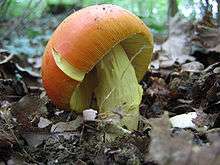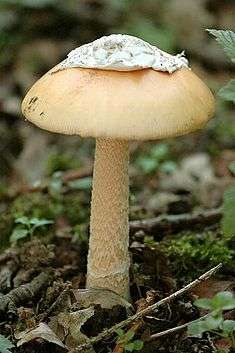Amanita
| Amanita | |
|---|---|
 | |
| Amanita muscaria Albin Schmalfuß, 1897 | |
| Scientific classification | |
| Kingdom: | Fungi |
| Division: | Basidiomycota |
| Class: | Agaricomycetes |
| Order: | Agaricales |
| Family: | Amanitaceae |
| Genus: | Amanita Pers. (1794) |
| Type species | |
| Amanita muscaria (L.) Lam. (1783) | |
| Diversity | |
| c.600 species | |
The genus Amanita contains about 600 species of agarics including some of the most toxic known mushrooms found worldwide, as well as some well-regarded edible species. This genus is responsible for approximately 95% of the fatalities resulting from mushroom poisoning, with the death cap accounting for about 50% on its own. The most potent toxin present in these mushrooms is α-amanitin.
The genus also contains many edible mushrooms, but mycologists discourage mushroom hunters, other than knowledgeable experts, from selecting any of these for human consumption. Nonetheless, in some cultures, the larger local edible species of Amanita are mainstays of the markets in the local growing season. Samples of this are Amanita zambiana and other fleshy species in central Africa, A. basii and similar species in Mexico, A. caesarea and the "Blusher" Amanita rubescens in Europe, and A. chepangiana in South-East Asia. Other species are used for colouring sauces, such as the red A. jacksonii with a range from eastern Canada to eastern Mexico.
Many species are of unknown edibility, especially in countries such as Australia, where many fungi are little-known.
Taxonomy
The name is possibly derived from Amanon, a mountain in Cilicia.
The genus Amanita was first published with its current meaning by Christian Hendrik Persoon in 1797.[1] Under the International Code of Botanical Nomenclature, Persoon's concept of Amanita, with Amanita muscaria (L.) Pers. as the type species, has been officially conserved against the older Amanita Boehm (1760), which is considered a synonym of Agaricus L.[2]
Toxicity

Several members of the section Phalloidieae are notable for their toxicity, containing toxins known as amatoxins, which can cause liver failure and death. These include the death cap A. phalloides; species known as destroying angels, including A. virosa, A. bisporigera and A. ocreata; and the fool's mushroom A. verna.
More recently, a series in the subgenus Lepidella has been found to cause acute renal failure, including A. smithiana of northwestern North America, A. pseudoporphyria of Japan, and A. proxima of southern Europe.[3]
Edibility

Although a few species of Amanita are edible, many fungi experts advise against eating a member of Amanita unless the species is known with absolute certainty.[4] Because so many species within this genus are so deadly toxic, if a specimen is identified incorrectly, consumption may cause extreme sickness and possibly death.
Edible species of Amanita include Amanita fulva (grisette), Amanita vaginata, Amanita calyptrata (coccoli), Amanita crocea, and Amanita rubescens (blusher), Amanita jacksonii (American Caesar's mushroom),Amanita citrina(false death cap). [5]
Inedible species of Amanita include Amanita albocreata (ringless panther), Amanita atkinsoniana, Amanita daucipes, Amanita excelsa, Amanita flavoconia, Amanita franchetii, Amanita longipes, Amanita magniverrucata, Amanita onusta, Amanita rhopalopus, Amanita silvicola, Amanita sinicoflava, Amanita spreta, and Amanita volvata.
Poisonous species include Amanita brunnescens, Amanita ceciliae, Amanita cokeri (Coker's amanita), Amanita crenulata, Amanita farinosa (eastern American floury amanita), Amanita flavorubescens, Amanita frostiana, Amanita muscaria (fly agaric), Amanita pantherina (panther cap), and Amanita porphyria.
Deadly poisonous species include Amanita abrupta, Amanita arocheae, Amanita bisporigera (eastern NA destroying angel), Amanita exitialis (Guangzhou destroying angel), Amanita magnivelaris, Amanita ocreata (western NA destroying angel), Amanita phalloides (death cap), Amanita smithiana, Amanita subjunquillea (East Asian death cap), Amanita verna (fool's mushroom), and Amanita virosa (European destroying angel).[5][6]
See also
References
- ↑ Persoon, C.H. (1797) Tent. disp. meth. fung.: 65
- ↑ J. McNeill et al. (eds)(2006) International Code of Botanical Nomenclature (Vienna, 2005), Appendix IIIA Nomina generica conservanda et rejicienda, B. Fungi http://ibot.sav.sk/icbn/main.htm
- ↑ Saviuc, P.; Danel, V. (2006). "New Syndromes in Mushroom Poisoning". Toxicological Reviews. 25 (3): 199–209. doi:10.2165/00139709-200625030-00004. PMID 17192123.
- ↑ Lincoff, Gary (1981). National Audubon Society Field Guide to Muschrooms. Knopf; A Chanticleer Press ed edition. p. 25. ISBN 0-394-51992-2.
- 1 2 Phillips, Roger (2010). Mushrooms and Other Fungi of North America. New York: Firefly Books. ISBN 978-1-55407-651-2.
- ↑ Zeitlmayr, L. (1976). Wild Mushrooms: An Illustrated Handbook. Hertfordshire: Garden City Press. p. 77. ISBN 0-584-10324-7.
External links
| Wikimedia Commons has media related to Amanita. |
- Rodham E. Tuloss and Zhu-liang Yang's Amanita site – Comprehensive listing of the nearly 600 named Amanita species with photos and/or technical details on over 510 species.
- "The genus Amanita" by Michael Kuo, MushroomExpert.Com, March 2005.

